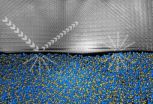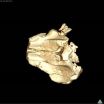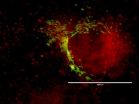(Press-News.org) CHICAGO --- Parents, forget the comfort food! It's time to send your college students care packages of fruit, veggies and exercise gear instead.
A new study from Northwestern Medicine® and Northeastern Illinois University found that the majority of college students are engaging in unhealthy behaviors that could increase their risk of cancer later on. Racial minority students could be at an even greater risk, especially African Americans and Native Americans.
A shocking 95 percent of college students fail to eat the recommended amount of fruit and vegetables (five or more servings a day), and more than 60 percent report not getting enough physical activity (three or more days of vigorous exercise for at least 20 minutes or five or more days of moderate exercise for at least 30 minutes a week).
"Changing unhealthy behaviors in college students now could be a way to reduce the risk of cancer as well as other diseases later in life," said Brian Hitsman, principal investigator of the study.
Hitsman is an assistant professor in preventive medicine-behavioral medicine and psychiatry and behavioral sciences at Northwestern University Feinberg School of Medicine and a member of the Robert H. Lurie Comprehensive Cancer Center of Northwestern University.
Published online May 5 in the journal Preventive Medicine, the study is the first to evaluate cancer risk behaviors and conditions in college students and how they vary by race and ethnicity. Data for the study comes from the fall 2010 wave of the National College Health Assessment, a self-reported survey of a diverse group of more than 30,000 college students in the United States.
The majority of all college students surveyed reported low fruit and vegetable consumption and low physical activity. Other unhealthy behaviors or conditions -- alcohol binge drinking, tobacco use and obesity/being overweight -- appear to cluster differently among college students depending on their race, the scientists found.
For example, tobacco use and alcohol binge drinking seem to go hand in hand for all subgroups except black students. For black students, tobacco use co-occurred with being overweight/obese.
"Tobacco use and obesity are two health issues that have been vying in the last five years for first place as the major health problem in the United States," said Joseph Kang, lead author of the study and assistant professor in preventive medicine-biostatistics at Feinberg. "It's frightening that those behaviors seem to co-occur in black students."
Native Americans were the only racial group in which there were students who engaged in all five unhealthy behaviors/conditions (alcohol binge drinking, tobacco use, insufficient fruit and vegetable consumption, low physical activity and obesity/being overweight). The finding was surprising and even more frightening than the profile for tobacco use and obesity in black students, Kang said.
Understanding cancer risk behavior clustering by race and ethnicity is critical given that the number of new cases is projected to increase by 45 percent by 2030 and surpass heart disease as the leading causes of death in the United States. (American Society of Clinical Oncology, 2014. The state of cancer care in America, 2014: a report by the American Society of Clinical Oncology. J. Oncol. Pract. 10, 119.). If left unaddressed in college students, there is potential for cancer rates to escalate even higher.
"There are major cancer disparities both in terms of risk, morbidity and mortality with racial and ethnic minorities in the United States," Hitsman said. "In this study, we see some of these behavioral risk factors already starting in young adulthood. Future research should monitor the persistence of cancer risk behavior clustering by race and ethnicity."
Other key results from the study broken down by race/ethnicity:
White students reported the highest prevalence of binge drinking (37.5 percent).
Asian students reported the highest rate of physical inactivity (74.6 percent).
Black students had the highest prevalence of insufficient fruit/vegetable intake (98.1 percent) but the lowest rates of tobacco use (13.6 percent) and binge drinking (17.1 percent).
Native American students had the highest rate of being overweight/obesity (51.4 percent).
Students who choose not to report their race/ethnicity (2.4 percent of the sample) reported the highest rate of tobacco use (27.9 percent).
INFORMATION:
This research was supported by the National Cancer Institute (P20CA165592, P20CA165588) of the National Institutes of Health and the Department of Health and Human Services, the Northwestern University Robert H. Lurie Comprehensive Cancer Center Director's Fund and the Bonnie Hunt Research Gift.
College kids need to change unhealthy ways
Today's college students are increasing the risk of cancer later on, especially racial minorities
2014-05-06
ELSE PRESS RELEASES FROM THIS DATE:
NeuroStar TMS therapy shows favorable outcomes compared to antidepressants for depression
2014-05-06
NEW YORK, May 6, 2014 – Neuronetics, Inc. announced today a new analysis of data at the annual meeting of the American Psychiatric Association that shows Transcranial Magnetic Stimulation (TMS) administered with the NeuroStar TMS Therapy System resulted in greater symptom improvement than next-choice conventional antidepressant medication among patients with Major Depressive Disorder (MDD) who failed to benefit from prior antidepressant medication. In a propensity-score matched analysis of data from two independent studies, patient-reported symptom outcomes measured by ...
Access to electronic health records may influence care
2014-05-06
Unlike medical records kept in paper charts, electronic health records (EHR) provide numerous access points to clinicians to review a patient's medical history. A new study has found access to electronic health records in acute care situations may influence the care given to that patient, and in some cases, failure to review the EHR could have adversely affected the medical management.
The findings are reported in the May 2014 edition http://content.healthaffairs.org/content/33/5/800.abstract of Health Affairs. John L. Ulmer, M.D., professor of radiology and chief of ...
Social workers can help patients recover from mild traumatic brain injuries
2014-05-06
More than a million people are treated for mild traumatic brain injuries in U.S. hospitals and emergency rooms each year. Yet few receive appropriate psychological and social follow-up care that can make the difference in whether or not they fully recover.
A University of Washington researcher has found that a 20-minute conversation with a social worker has the potential to significantly reduce the functional decline of those diagnosed with a mild traumatic brain injury.
The research is published in the April issue of Brain Injury.
Megan Moore in the UW's School of ...
Study shows that impulsivity is risk factor for food addiction
2014-05-06
(Boston) – Have you ever said to yourself that you would only have a handful of potato chips from the bag then, minutes later, realized you ate the whole thing? A recent study shows that this type of impulsive behavior might not be easily controlled – and could be a risk factor in the development of food addiction and eating disorders as a result of cellular activities in the part of the brain involved with reward.
The research, published online in Neuropsychopharmacology, was led by Boston University School of Medicine (BUSM) and conducted in collaboration with the University ...
Linking vascular inflammation to obesity and atherosclerosis
2014-05-06
A study in The Journal of Experimental Medicine shows that IκB kinase β (IKKβ) functions in smooth muscle cells to regulate vascular inflammatory responses and atherosclerosis development.
Inflammatory responses are the driving force of atherosclerosis, a process that involves the hardening and thickening of artery walls due to excess fatty deposits. IKKβ is a central coordinator of inflammatory responses that has been implicated in vascular diseases, but its role in atherosclerosis has been unclear.
Now, Changcheng Zhou and colleagues from the ...
Staying on task in the automated cockpit
2014-05-06
Automation in the cockpit is traditionally believed to free pilots' attention from mundane flight tasks and allow them to focus on the big picture or prepare for any unexpected events during flight. However, a new study published in Human Factors indicates that pilots may have a hard time concentrating on the automated systems that now carry out many of the tasks once completed by humans.
"The automated systems in today's cockpits assume many of the tasks formerly performed by human pilots and do it with impressive reliability," says Stephen Casner, coauthor of "Thoughts ...
Graphene for real-world devices
2014-05-06
Graphene, a one-atom-thick form of the carbon material graphite, has been hailed as a wonder material — strong, light, nearly transparent, and an excellent conductor of electricity and heat. But a number of practical challenges must be overcome before it can emerge as a replacement for silicon and other materials in microprocessors and next-generation energy devices.
One particular challenge concerns the question of how graphene sheets can be used in real devices.
"When you fabricate devices using graphene, you have to support the graphene on a substrate and doing ...
Cedars-Sinai researchers identify how heart stem cells orchestrate regeneration
2014-05-06
LOS ANGELES (EMBARGOED UNTIL NOON ET ON MAY 6, 2014) – Investigators at the Cedars-Sinai Heart Institute – whose previous research showed that cardiac stem cell therapy reduces scarring and regenerates healthy tissue after a heart attack in humans – have identified components of those stem cells responsible for the beneficial effects.
In a series of laboratory and lab animal studies, Heart Institute researchers found that exosomes, tiny membrane-enclosed "bubbles" involved in cell-to-cell communication, convey messages that reduce cell death, promote growth of new heart ...
Redescription of the oldest-known dolphin skull sheds light on their origins and evolution
2014-05-06
VIDEO:
This is the CT image of the skull of the holotype of Eodelphis kabatensis.
Click here for more information.
Dolphins are the most diverse family of living marine mammals and include species such as the bottlenose dolphin and the killer whale. However, their early evolution and fossil record has been steeped in mystery due to lack of good specimens. A new paper published in latest issue of the Journal of Vertebrate Paleontology re-describes the oldest species of dolphin ...
One step closer to cell reprogramming
2014-05-06
In 2012, John B. Gurdon and Shinya Yamakana were awarded the Nobel Prize in medicine for discovering that adult cells can be reprogrammed into pluripotent ones (iPS); the cells obtained are capable of behaving in a similar way to embryonic stem cells, and hence have enormous potential for regenerative medicine.
However, although there are many research groups around the world studying this process, it is still not completely understood, it is not totally efficient, and it is not safe enough to be used as the basis for a new cell therapy.
Now, researchers at the Centre ...
LAST 30 PRESS RELEASES:
Synergistic effects of single-crystal HfB2 nanorods: Simultaneous enhancement of mechanical properties and ablation resistance
Mysterious X-ray variability of the strongly magnetized neutron star NGC 7793 P13
The key to increasing patients’ advance care medical planning may be automatic patient outreach
Palaeontology: Ancient tooth suggests ocean predator could hunt in rivers
Polar bears may be adapting to survive warmer climates, says study
Canadian wildfire smoke worsened pediatric asthma in US Northeast: UVM study
New UBCO research challenges traditional teen suicide prevention models
Diversity language in US medical research agency grants declined 25% since 2024
Concern over growing use of AI chatbots to stave off loneliness
Biomedical authors often call a reference “recent” — even when it is decades old, analysis shows
The Lancet: New single dose oral treatment for gonorrhoea effectively combats drug-resistant infections, trial finds
Proton therapy shows survival benefit in Phase III trial for patients with head and neck cancers
Blood test reveals prognosis after cardiac arrest
UBCO study finds microdosing can temporarily improve mood, creativity
An ECOG-ACRIN imaging study solves a long-standing gap in metastatic breast cancer research and care: accurately measuring treatment response in patients with bone metastases
Cleveland Clinic presents final results of phase 1 clinical trial of preventive breast cancer vaccine study
Nationally renowned anesthesiology physician-scientist and clinical operations leader David Mintz, MD, PhD, named Chair of the Department of Anesthesiology at the UM School of Medicine
Clean water access improves child health in Mozambique, study shows
Study implicates enzyme in neurodegenerative conditions
Tufts professor named Fellow of the National Academy of Inventors
Tiny new device could enable giant future quantum computers
Tracing a path through photosynthesis to food security
First patient in Arizona treated with new immune-cell therapy at HonorHealth Research Institute
Studies investigate how AI can aid clinicians in analyzing medical images
Researchers pitch strategies to identify potential fraudulent participants in online qualitative research
Sweeping study shows similar genetic factors underlie multiple psychiatric disorders
How extreme weather events affect agricultural trade between US states
Smallholder farms maintain strong pollinator diversity – even when far from forests
Price of a bot army revealed across hundreds of online platforms worldwide – from TikTok to Amazon
Warblers borrow color-related genes from evolutionary neighbors, study finds
[Press-News.org] College kids need to change unhealthy waysToday's college students are increasing the risk of cancer later on, especially racial minorities



